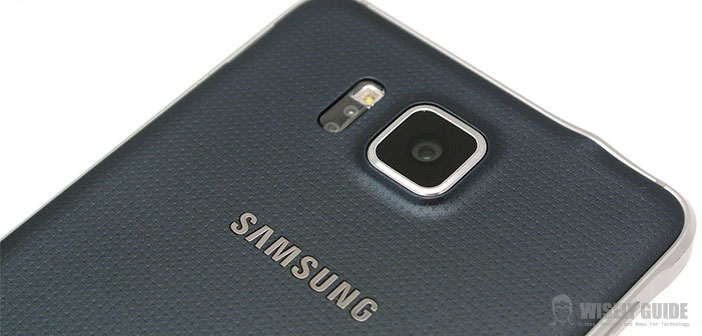Samsung Galaxy Alpha is the first smartphone flagship of the latest generation of the company to integrate metal parts for the body. In this case, it is chosen only for the aluminum frame, so as to maintain the advantages of the polycarbonate on the front of the durability, and the feeling of the metal to enter in the category of premium smartphones. It will be enough? The answer in the review.
Samsung Galaxy Alpha – Introduction and Specifications.
Samsung Galaxy Alpha marks a clear passage in the commercial strategy of Samsung. It is the first South Korean flagship Android to having metal trim along the body, the first to set a new direction in style again, later, with the Galaxy Note 4. The market leader globally denies, but only partially, press releases issued in the past on the use of polycarbonate as the material best for smartphones, introducing a special metal frame along the body of the new Alpha.
The name has multiple meanings: it indicates the first model of the new family, but also the first of a new styling in which the functionality of the polycarbonate can bring the feeling of the typical premium top of the range of competitors, who are fighting on the use the material more exclusive.
Samsung Alpha Galaxy is a smartphone aluminum which we must pay particular attention around the surface to support him: the back is made of polycarbonate with soft rubber finish and also reduce body is made of aluminum unibody.
Samsung has taken the approach ” hybrid “, giving its Alpha all the features of a device with removable body, such as the ability to replace the battery easily and at any time (this is instead a microSD slot).
To do this we opted for a traditional plastic shell, which is further protected by a thin layer of polycarbonate removable with ease, and that betrays the characterization premium desired by Samsung for the model. Samsung Alpha Galaxy offers high and low from the point of view of style, with valuable insights and details improved.
| Samsung Galaxy Alpha | iPhone 6 | |
| OS | Android 4.4.4 (KitKat) | iOS 8 |
| CPU | 5 octa-core Exynos 5430 CPU 1: ARM Cortex-A15 1.8GHz CPU 2: 1.3 GHz ARM Cortex-A7 |
Apple A8 dual-core 1.4 GHz 64-bit + M8 |
| RAM | 2 GB | 1 GB |
| Display | SuperAMOLED 4.7″ | IPS LCD 4.7″ |
| Resolution | 1280×720 | 1334×750 |
| Pixel | 312 PPI | 326 PPI |
| Storage | 32 GB not expandable |
16/64/128 GB not expandable |
| Front Camera | 2.1 MP | 1.2 MP |
| Rear Camera | 12 MP f/2.2 LED Flash |
8MP f/2.2 Dual LED Flash |
| Mobile Network | Up to 4G LTE-A Cat. 6 | Up to 4G LTE |
| Wi-Fi | 802.11 ac | 802.11 ac |
| Bluetooth | 4.0 | 4.0 |
| Connectivity | NFC DLNA ANT + |
NFC (only with Apple Pay) AirPlay |
| Geolocation | GPS, A-GPS | GPS with GLONASS |
| Sensors | Accelerometer Proximity Gyro Compass Scan Fingerprint Heart |
Accelerometer Proximity Gyro Compass Touch ID Barometer |
| Ports | microUSB 3.5mm Audio Jack |
Lightning 3.5mm audio jack |
| Battery | 1,860 mAh | 1,810 mAh |
| Dimensions | 132.4 x 65.5 x 6.7 mm | 138.4 x 67 x 6.9 mm |
| Weight | 115 g | 129 g |
There is no doubt that Samsung will appeal to users who in the past chose the iPhone with the new model, and this is especially noticeable in the list of the hardware features of the smartphone. The Koreans abandoned the run-up to the thumb with the new Samsung Galaxy Alpha, with its integration of a display of 4.7″, on the line of the rumors of what would later be iPhone 6, within a chassis is extremely small in size and in thickness. Alpha wants to be the direct competitor of the iPhone 6, with the objective to hit him in his own unique aspects: a top of the range mini, highly optimized.
From the point of view of the video resolution, we are not in front of the extreme version of the technology currently available on the market, but a solution commensurate with the Exynos SoC hardware power allowed by the owner, in order to provide seamless user experience and pleasant, not compromised by screens too exorbitant to manage CPU and GPU integrated.
Two cameras, including the main one is located along the rear surface in a central and slightly protruding. The sensor is 12 MP, while the lens offers an aperture of aperture of f/2.2 when shooting bright. The rear module is completed with an LED flash for shots at close range in the dark.
No solution particularly exotic to the front end and for lovers of so-called Selfie, which uses a sensor to 2.1MP. There are plenty of traditional motion sensors, such as accelerometer, gyroscope and compass, and in addition there is a dedicated heart-rate monitor (and very effective) and a biometric sensor for fingerprint scanning (actually not very accurate and reliable).
Samsung is due to compromises on the front of the operational, with a battery of 1,860 mAh which not only allows logically miracles from the point of view of operational autonomy. Please refer to the following pages for a description aesthetics of the smartphone, the high-resolution photos and analysis of performance and autonomy of the smartphone, so you can trace the conclusions and compare it to its direct competitor, the iPhone 6 from Apple.



